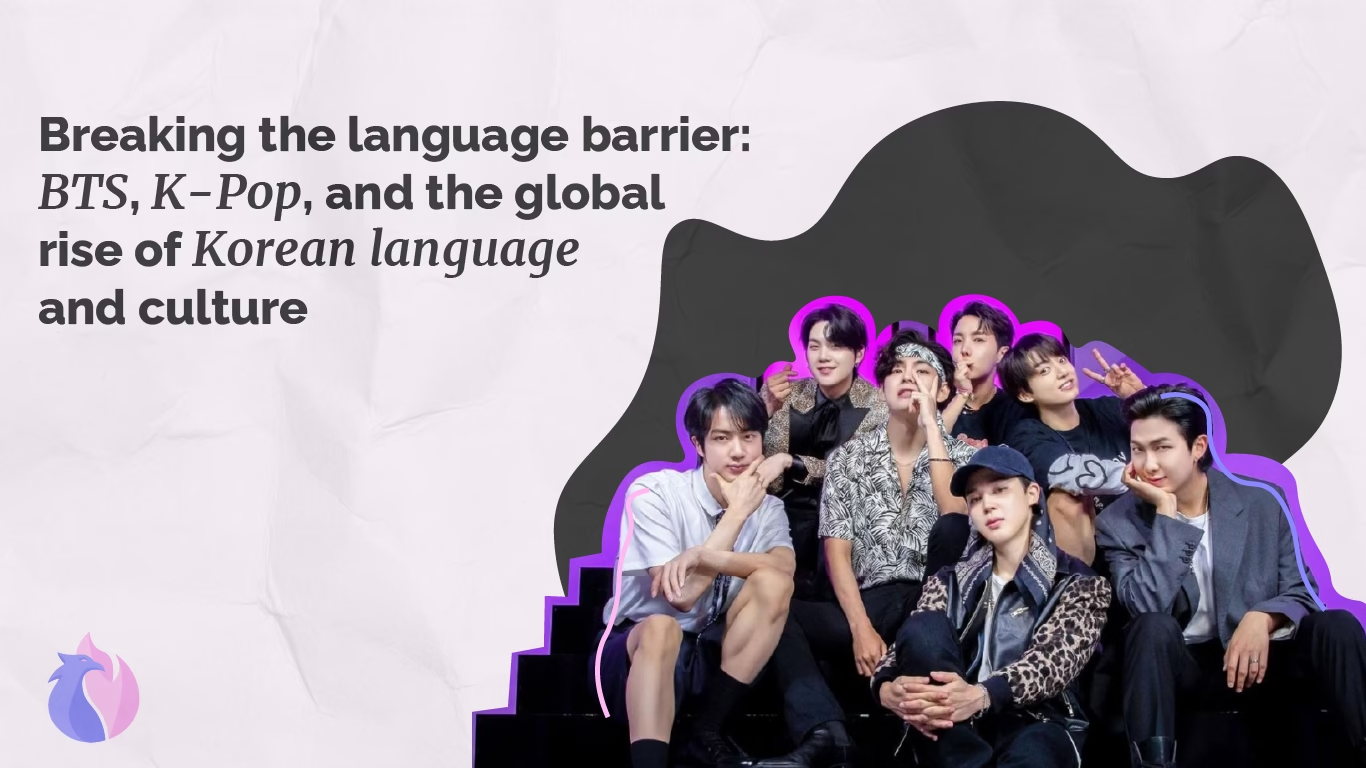
BTS, a seven-member boy band from South Korea, once seemed unlikely candidates to conquer global music charts—singing mostly in Korean, a language spoken primarily in one country. Yet by the late 2010s, BTS and fellow K-pop artists had built a worldwide following that transcended language barriers.
Fans from São Paulo to Moscow were not only dancing to Korean lyrics but even learning them, signaling an unprecedented boom in interest in the Korean language and culture.
This article explores how BTS and the K-pop industry achieved this cultural phenomenon, backed by data and expert insights. It delves into the multilingual strategies and accessible platforms that made Korean content globally approachable, the ripple effects on language learning and cultural engagement, and what lessons this holds for educators and brands on the power of cultural storytelling in bridging communication gaps.
K-Pop’s Global Breakthrough Across Language Barriers
Korean pop music – K-pop – has proven that music can indeed travel beyond language. In 2018, BTS’s album Love Yourself: Tear (sung predominantly in Korean) hit No.1 on the U.S. Billboard 200 chart, the first album in a non-European language ever to do so.
This feat was as unexpected as a Mongolian novel winning the Booker Prize or a Finnish film taking Best Picture at the Oscars – Korean, after all, had virtually no global pop-culture presence a decade prior. Nevertheless, millions of BTS fans worldwide now sing along in Korean, demonstrating that passionate storytelling and performance can overcome linguistic gaps.
The group’s energetic performances, social media savvy, and authentic narratives helped create a devoted international fanbase (ARMY) that feels emotionally connected despite not sharing a native tongue.
A large part of K-pop’s international success stems from its multimedia outreach and online community. BTS and other idols leveraged YouTube, Twitter, and other platforms to share music videos, behind-the-scenes footage, and personal messages in real time.
Fans not only consumed content but actively promoted and defended their artists, coordinating across continents. In this social media age, language barriers grew less relevant: viral dance challenges, eye-catching visuals, and relatable themes communicated universally.
BTS’s Multilingual and Cultural Strategies
While K-pop’s rise owes much to fans, the artists and industry also adopted multilingual and culturally adaptive strategies. BTS balanced staying true to their Korean identity with reaching global audiences.
From early on, BTS songs included English phrases or hooks, making them catchy for international listeners while keeping verses in Korean. Later, they released full-English hits like “Dynamite” and “Butter”, which topped charts worldwide without diminishing interest in their Korean songs.
Beyond English, BTS has embraced Japanese, Spanish, Mandarin, and even French in their music and content. These gestures signal appreciation for diverse fanbases and enhance connection.
Importantly, BTS’s lyrics and public speeches often tackle universal themes—mental health, self-esteem, equality—rooted in Korean context. Their United Nations speeches blended Korean and English, showing cultural pride while bridging gaps for a global audience.
The Data: A Korean Language Boom Fueled by Pop Culture
The Korean Wave (Hallyu) has driven a worldwide boom in Korean language learning.
On Duolingo, Korean is now one of the top languages studied globally, surpassing Italian and Chinese. In the U.S., Korean course enrollment in universities has more than doubled over the last decade.
Globally, the King Sejong Institute Foundation now operates nearly 250 Korean language and culture centers in over 80 countries, teaching more than 200,000 students annually.
This growth mirrors record-breaking Korean cultural exports, from music and TV to beauty products and gaming.
Fan-Driven Translation and Accessible Platforms
BTS’s global reach owes much to fans themselves.
Volunteer translators ensure no lyric, interview, or livestream goes untranslated. Teams and individuals provide subtitles and translations into dozens of languages, often within hours.
Platforms like V Live and Weverse also helped: V Live offered content with translations in many languages, while Weverse built in automatic translation and real-time subtitles for live events.
HYBE’s “Learn Korean with BTS” further broke down barriers by teaching Korean basics using BTS clips—turning fan curiosity into learning.
Beyond Music: Global Fans Embrace Korean Media, Education and Tourism
Many K-pop fans expand their interest to K-dramas, Korean films, cuisine, and traditions. Netflix’s Squid Game became its most-watched series, sparking further cultural curiosity.
Korean language programs at universities are booming, with some experiencing waitlists. Fans also travel to Korea for concerts, cultural sites, and filming locations.
Some even celebrate Korean holidays, cook Korean food, or study in Korea, showing how entertainment can lead to deeper cultural engagement.
Lessons for Global Brands and Educators
BTS’s rise shows the power of authentic cultural storytelling.
They proved that staying true to your identity while localizing content strategically can win global audiences. For brands, that means maintaining authenticity while making content accessible in multiple languages and contexts.
Community is key—BTS’s ARMY became a global network of advocates. Brands and educators can replicate this by fostering active participation, peer learning, and cultural exchange.
Finally, pop culture can be a gateway to language learning and cross-cultural understanding. Governments, educators, and companies can leverage this to inspire new audiences and break communication barriers.
Sources:
- Lee, Soonyoung. Forbes interview on growth in Korean language study bard.edu bard.edu.
- King Sejong Institute Foundation, 2024 report on global Korean learners ksif.or.kr ksif.or.kr.
- Ahn, L. (2025). Chosun Ilbo interview with Duolingo CEO m.news.zum.com m.news.zum.com.
- Ministry of Culture, Sports and Tourism (Korea), content exports data ifacca.org.
- Korea Foundation, Global Hallyu Statistics 2023 kf.or.kr.
- C. Pang, “K-Pop Your Way In,” Keystone (Feb 2024) keg.com keg.com.
- Kwon, M. (2019). Korea Herald on fan translators allkpop.com allkpop.com.
- Park, S.S. (2018). “Korean Pop: BTS and Fan Translation,” Creative Multilingualism creativeml.ox.ac.uk creativeml.ox.ac.uk.
- Ribeiro, A.C. (2021). “All the Languages of BTS,” Medium anaribeiro-br.medium.com anaribeiro-br.medium.com.
- Weverse Magazine, “The world of K-pop translators” (2023) magazine.weverse.io magazine.weverse.io.
- Study International, “Learn Korean with BTS” details studyinternational.com studyinternational.com.
- Says.com, citing MCST Korea tourism report (2024) says.com.

Leave a Reply